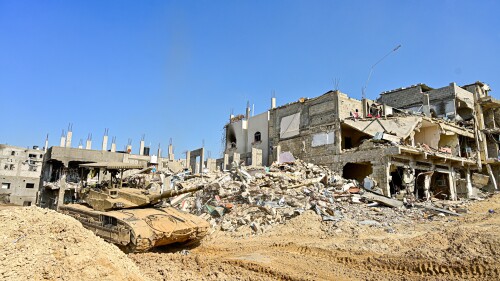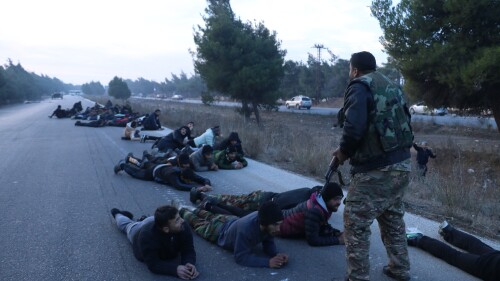Originally published under the title “Reality Matters in Middle East, not Trump’s Jerusalem Symbolism.”
Clockwise from top left: Arab neighborhoods of Jerusalem were largely peaceful as tens of thousands demonstrated against U.S. recognition of Jerusalem as Israel’s capital in Lebanon, Morocco and Turkey. |
The neighborhood where I live, on the seam line dividing Jew and Arab in Jerusalem, can be a useful place to take the temperature of the Israeli-Palestinian conflict.
In 2015, a wave of stabbing attacks against Israelis and Jews began. This was the result of a campaign of incitement by Islamist groups according to which the government of Israel planned to change the status quo regarding the Temple Mount/Haram al-Sharif.
A number of the stabbers came from close by, and for a while, a police roadblock appeared on the main street. Petrol bombs were thrown at a Jewish house in the neighborhood in February, 2016, at the height of that period of unrest.
In late 2014, just after the Gaza war, Palestinian youths threw stones at police in the neighborhood, after the police shot dead a man who had tried to kill a prominent Jewish activist who led a campaign to demand Jewish prayer rights on the Temple Mount.
Since the announcement by President Donald Trump of US recognition of Jerusalem as the capital of Israel this month, however, the neighborhood has been quiet and serene. People are going on with their everyday lives.
The difference at ground level with previous periods of tension is notable and significant.
Of course, the situation in a single seam line neighborhood cannot reflect the whole picture. The occasion has not passed without injury and loss of life. Hamas declared three ‘days of rage’ following Trump’s announcement. Two Palestinians were killed and 98 wounded in the subsequent demonstrations.
There was rioting in Wadi Ara, inside the borders of Israel. An Israeli security guard was stabbed and critically wounded at Jerusalem’s Central Bus Station on Sunday. And in Gaza, the rocket launching activities of small militant groups are leading to a significant rise in tension.
But attendance at the Jerusalem and West Bank protests has been notably poor – a few thousand across the entire area. This week, the demonstrations have dwindled further.
Most Palestinians appear to recognize that Trump’s declaration had no immediate practical import.
What might explain the relatively minor dimensions of the protests?
First of all, President Trump’s declaration was just that – a declaration. With no immediate practical import.
But there are other important factors. In Jerusalem, Christmas and New Year bring with them throngs of tourists. Palestinian traders and businesses in the east of the city stand to gain from their presence. Many do not want to help fan the flames of a situation that will lead to the tourists staying at home.
The general quiet of recent months has brought with it opportunities for engaging in commerce, education. People are keen to preserve these opportunities. This situation is fragile, of course. A single incident could transform it. But for the moment, it is holding.
Palestinian traders and businesses don’t want holiday tourists to stay at home.
One should also factor in the searing experience of the Second Intifada in the 2000-4 period. This was an armed insurgency ,in which 3000 Palestinians and 1000 Israelis lost their lives. Together with the close-by examples of Syria, Egypt and Iraq, it constitutes a stark warning of the abyss that can wait beyond a decision for revolt.
The relative quiet in Jerusalem and the West Bank is in contrast to the fury expressed further afield against Trump’s declaration.
One of the salient features of the Israeli-Palestinian conflict, in contrast with other ethno-religious land disputes in the Middle East, is that it has an enormous symbolic significance for populations in the broader Arab and Muslim world and beyond who have no tangible and practical involvement with it.
Those whose interest is in the conflict as a symbol are not, of course, held back by the pragmatic and practical considerations of those who actually live it.
Police outside a synagogue that was attacked in Gothenburg, Sweden, on December 9. |
There has in consequence been in recent days a wave of fury against Israel and Jewish targets far from Israel itself. This has included attacks on synagogues in Gothenburg and Malmo in Sweden, angry demonstrations replete with anti-Semitic chanting in London, Berlin and beyond. A grim warning from Turkish President Recep Tayep Erdogan to Trump that Jerusalem is a ‘red line’ for Muslims, and Hizballah leader Hassan Nasrallah telling a crowd (via video screen) in Beirut that the US announcement represented the ‘beginning of the end’ for Israel. The attempted suicide bombing in New York too may at least partially have been inspired by the suffering of Muslims in Gaza.
At the most absurd end, even Malaysian Defense Minister Datuk Seri Hishammuddin Tun Hussein said his country’s armed forces were ready to play some (unspecified) role on behalf of Muslim and Palestinian claims in Jerusalem.
What is it about this conflict that makes it raise these emotions across the globe, in a way that the far bloodier neighboring conflicts in, say, Syria, Iraq or Yemen demonstrably fail to do?
One explanation might be that these other conflicts are intra-Islamic affairs, while that between Israelis and Palestinians places a largely Muslim people against a largely Jewish one. Another possible angle could be that Israel is associated with the democratic west, and hence its actions strike historic chords that are absent elsewhere. A third reason might be the traditional attitudes of contempt toward Jews that prevail according to all polling evidence throughout the Muslim world.
In any case, the reality is clear. The embassies of Iran and Russia throughout Europe remain almost entirely untroubled by protests, despite the role of those countries in assisting Bashar Assad to murder hundreds of thousands of his own people over the last seven years. US embassies throughout the Islamic world and Europe have, by contrast, in recent days witnessed furious crowds protesting Trump’s announcement.
No Arab country expelled its US ambassador following Trump’s announcement.
And while Jerusalem and the West Bank remain largely quiet, the fury further afield is unabating.
There is a third interesting layer to all this. Palestinian President Mahmoud Abbas on December 11 noted that no Arab country had expelled its US ambassador or taken any active measures following the announcement. Nor is any such action imminent or likely.
In the tangible, decidedly non-symbolic world of Mid-East strategy and politics, as in the seam line neighborhoods of Jerusalem, the Trump declaration seems of secondary significance.
In the same week that the announcement was made, a far less reported event and the response to it reveals much about the underlying realities of the region.
The leader of the Iranian-backed Iraqi Shi’a militia Asaib Ahl al-Haq, Qais al-Khazali (left), at the Lebanese-Israeli border. |
An Iran-supported Iraqi Shia militia leader, one Qais al-Khazaleh, in a video released on Saturday, was shown visiting the Lebanese-Israeli border, in the company of members of Hizballah. “I’m here with my brothers from Hezbollah, the Islamic Resistance,’ Khazaleh says on the video. ' We announce our full preparedness to stand as one with the Lebanese people with the Palestinian cause in the face of the unjust Israeli occupation. [An occupation] which is anti-Islam, anti-Arab, and anti-humanity, in the decisive Arab Muslim cause.’
Al-Khazaleh’s statement was quickly picked up in the main outlets of both the Saudi and the Israeli media. The visit became a major subject in media discussion in both countries.
Prominent Saudi journalist Abd al-Rahman al Rashid,whose columns tend to reflect official Saudi thinking, noted al-Khazaleh’s status as a servant of Iran, and wrote in the Saudi Asharq al-Awsat newspaper ‘Now that Iran dominates Syria, Lebanon’s situation became annexed to the war’s results and agreements. Tehran’s domination increased to an extent that it now dares to send its militias and their leaders to demarcation lines with Israel attempting to drag it into a new war.’
This statement, from a Saudi journalist close to the corridors of power in Riyadh, reflects the real and non-symbolic nature of current power politics in the Middle East. Al-Rashid holds the Iran-led camp entirely responsible for any deterioration. Al-Khazaleh, it is worth remembering, is an Arab and a Muslim (albeit a Shia). He refers to the Palestinian case as the ‘decisive Arab cause.’ No matter. For al Rashid, he is aligned with Iran and Israel is Iran’s enemy. So the Saudi journalist’s sympathies, without quite stating it plainly, are clearly with Israel.
Arab leaders are primarily concerned with the advance of Iranian power in Yemen, Iraq, Syria and Lebanon.
Whatever the theological disagreements, both Israel and Saudi Arabia (along with a host of other regional players including the UAE, Jordan and Egypt) are currently primarily concerned at the advance of Iranian power in the collapsed spaces in the region – in Yemen, Iraq, Syria and Lebanon. This core alignment is based on clear shared interests and it is unlikely to change as a result of Trump’s recent declaration.
This does not mean, of course, that these countries have any sympathy for Israeli or Jewish aspirations or claims in Jerusalem. They decidedly do not. It does, however, mean that when it comes to practicalities, more tangible and urgent threats will tend to take preference over symbolic matters. The latter will be the subject of lip service. And not much else.
So in the neighborhoods of Jerusalem’s seam line, daily concerns and interests appear – currently at least – to precariously take precedence. In the halls of regional power, too, beneath the rhetoric, self-preservation currently trumps symbolism.
Outside of the region, far from danger, pure symbolism can be indulged at no potential cost. So ideas and maximal aspirations continue to run free, unfettered by the bonds of reality. In the meantime, Iran is continuing to patiently advance its cause in the collapsed states of the Arab Middle East, amid the collapsed assumptions of Arab politics.
Jonathan Spyer, a fellow at the Middle East Forum, is director of the Rubin Center for Research in International Affairs and author of The Transforming Fire: The Rise of the Israel-Islamist Conflict (Continuum, 2011).










